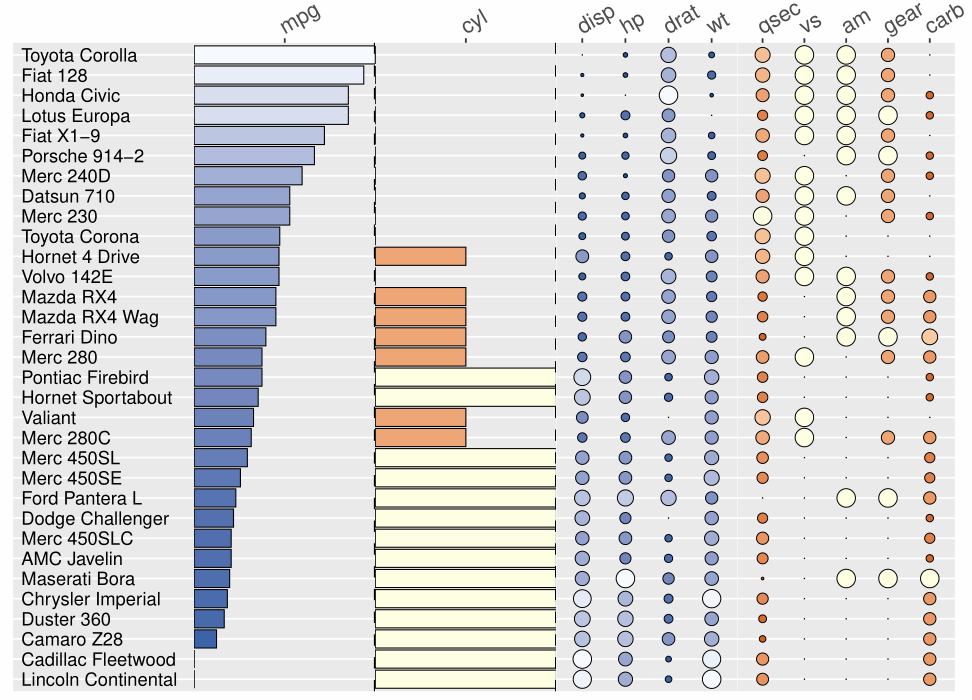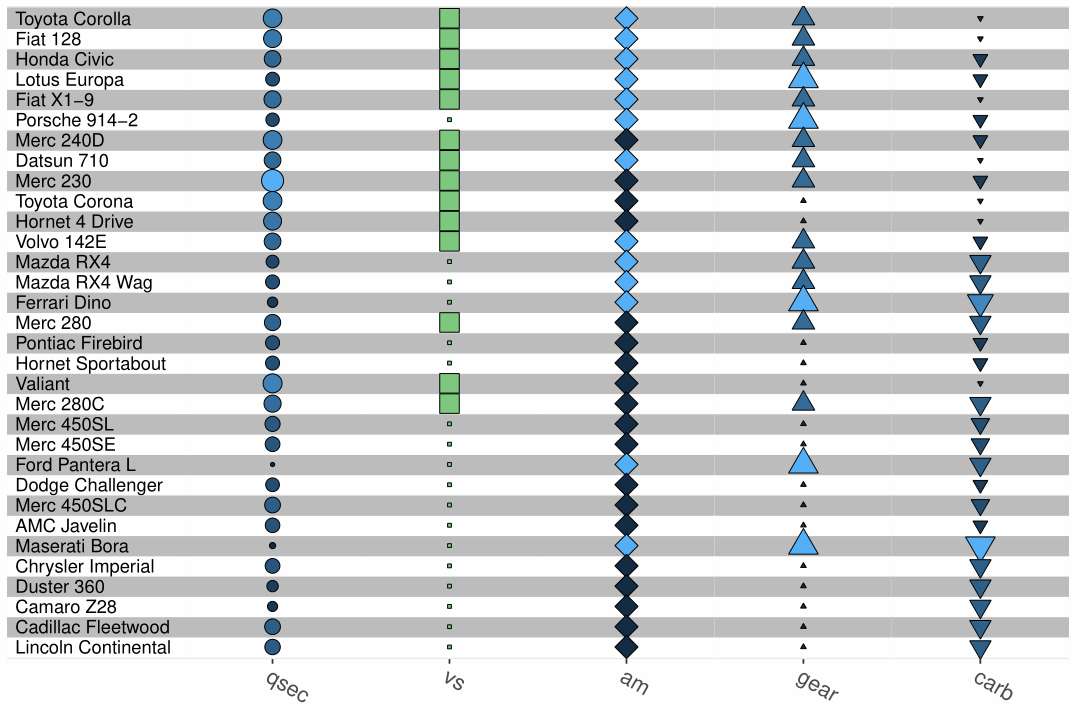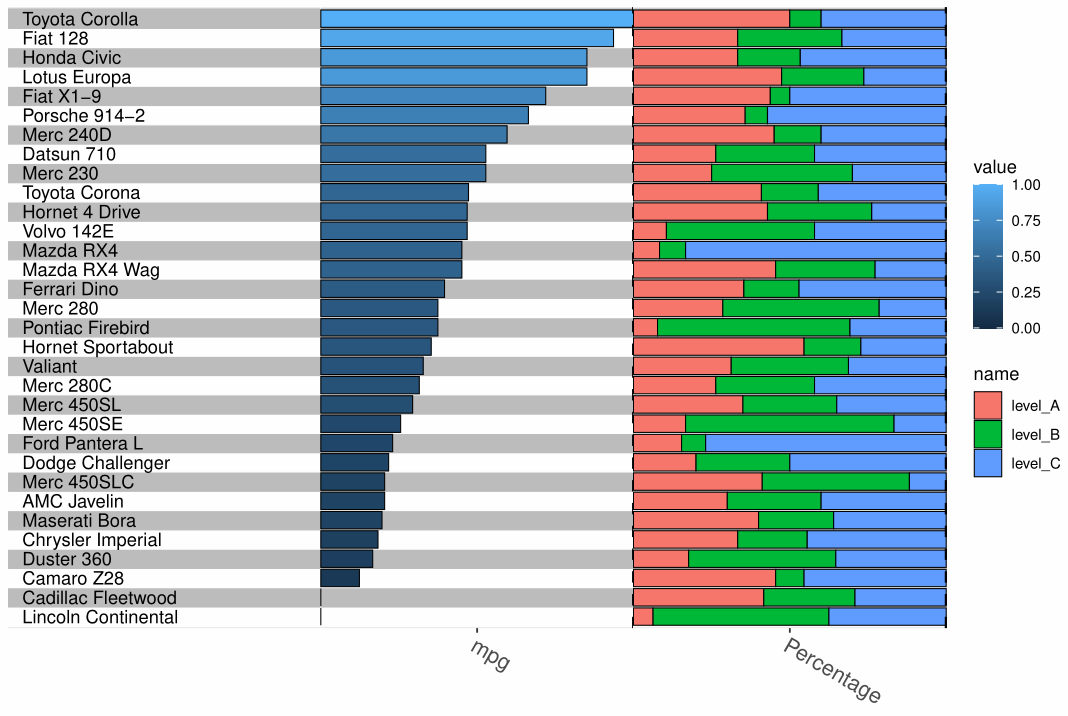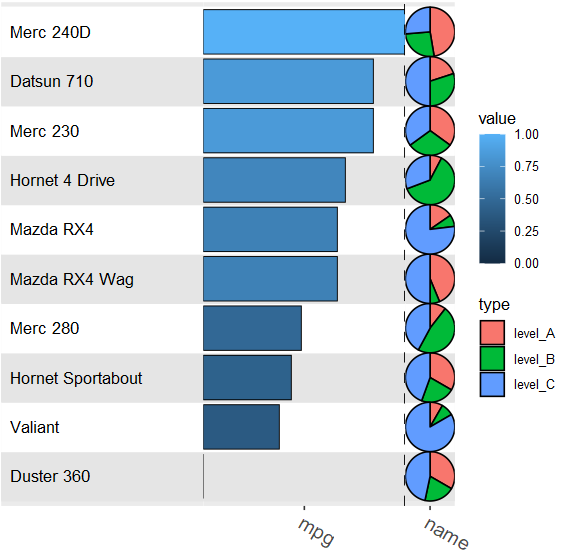Dear Professor Guang,
I appreciate the opportunity to contribute to the discussion. After carefully considering the problem and learning the two R package (here is my simple notes for aplot and funkheatmap). I have come up with a possible solution to try to produce that demonstrated figure of funkheatmap.
The figure below is the result and following is my R codes

library(aplot)
library(tidyverse)
data("mtcars")
## step1 - firstly perform 0~1 normalization
normalize_0_1 <- function(data) {
normalized_data <- apply(data, 2, function(x) {
(x - min(x, na.rm = TRUE)) / (max(x, na.rm = TRUE) - min(x, na.rm = TRUE))
})
return(normalized_data)
}
data_sc <- normalize_0_1(mtcars) %>%
as.data.frame() %>%
rownames_to_column("id") %>%
arrange(desc(mpg))
## step2 - then draw 5 subplots sequentially from right to left
# fig1:Dotplot
p1 <- data_sc[,c(1,4:7)] %>%
reshape2::melt("id") %>%
dplyr::mutate(id=factor(id, levels = rev(data_sc$id))) %>%
ggplot(aes(x = variable, y = id)) +
geom_point(aes(size=value, fill=value), stroke = 0.3, shape=21) +
scale_size_continuous(range = c(0, 5)) +
scale_fill_gradient(low = "#08519C", high = "#F7FBFF") +
scale_x_discrete(position = "top") +
theme(legend.position = "none") +
theme(axis.text.x = element_text(angle = 30, hjust = 0, size=13)) +
theme(axis.ticks.y = element_blank(),
axis.text.y = element_blank(),
axis.line.y = element_blank(),
axis.title = element_blank(),
axis.ticks.length.y = unit(0,"pt"),
plot.margin = margin()) +
theme(panel.grid.major.x = element_blank(),
panel.grid.minor.x = element_blank())
# fig2:Dotplot
p2 <- data_sc[,c(1,8:12)] %>%
reshape2::melt("id") %>%
dplyr::mutate(id=factor(id, levels = rev(data_sc$id))) %>%
ggplot(aes(x = variable, y = id)) +
geom_point(aes(size=value, fill=value), stroke = 0.3, shape=21) +
scale_size_continuous(range = c(0, 5)) +
scale_fill_gradient(low = "#CC4C02", high = "#FFFFE5") +
scale_x_discrete(position = "top") +
theme(legend.position = "none") +
theme(axis.text.x = element_text(angle = 30, hjust = 0, size=13)) +
theme(axis.ticks.y = element_blank(),
axis.text.y = element_blank(),
axis.line.y = element_blank(),
axis.title = element_blank(),
axis.ticks.length.y = unit(0,"pt"),
plot.margin = margin()) +
theme(panel.grid.major.x = element_blank(),
panel.grid.minor.x = element_blank())
# fig3:bar plot
p3 <- data_sc[,c(1,3)] %>%
dplyr::mutate(id=factor(id, levels = rev(data_sc$id))) %>%
ggplot(aes(x = id, y = cyl)) +
geom_col(aes(fill=cyl), color="black", linewidth=0.3) +
geom_hline(yintercept = 1, linetype="dashed", linewidth=0.8) +
scale_fill_gradient(low = "#CC4C02", high = "#FFFFE5") +
scale_y_continuous(position = "right", expand=c(0,0),
breaks = c(0.5),
labels = c("cyl")) +
coord_flip() +
theme(legend.position = "none") +
theme(axis.text.x = element_text(angle = 30, hjust = 0, size=13)) +
theme(axis.ticks.y = element_blank(),
axis.text.y = element_blank(),
axis.line.y = element_blank(),
axis.title = element_blank(),
axis.ticks.length.y = unit(0,"pt"),
plot.margin = margin(0,2,0,0)) +
theme(panel.grid.major.x = element_blank(),
panel.grid.minor.x = element_blank())
# fig4:bar plot
p4 <- data_sc[,c(1,2)] %>%
dplyr::mutate(id=factor(id, levels = rev(data_sc$id))) %>%
ggplot(aes(x = id, y = mpg)) +
geom_col(aes(fill=mpg), color="black", linewidth=0.3) +
geom_hline(yintercept = 1, linetype="dashed", linewidth=0.8) +
scale_fill_gradient(low = "#08519C", high = "#F7FBFF") +
scale_y_continuous(position = "right", expand=c(0,0),
breaks = c(0.5),
labels = c("mpg")) +
coord_flip() +
theme(legend.position = "none") +
theme(axis.text.x = element_text(angle = 30, hjust = 0, size=13)) +
theme(axis.ticks.y = element_blank(),
axis.text.y = element_blank(),
axis.line.y = element_blank(),
axis.title = element_blank(),
axis.ticks.length.y = unit(0,"pt"),
plot.margin = margin(0,0,0,0)) +
theme(panel.grid.major.x = element_blank(),
panel.grid.minor.x = element_blank())
# fig5:text plot
p5 <- data_sc[,1,drop=F] %>%
dplyr::mutate(value=1) %>%
ggplot(aes(x = id, y = value)) +
geom_text(aes(label = id),
hjust = 0) +
coord_flip() +
ylim(c(1, 2)) +
theme(axis.ticks = element_blank(),
axis.text = element_blank(),
axis.line = element_blank(),
axis.title = element_blank(),
axis.ticks.length.y = unit(0,"pt"),
plot.margin = margin(0,0,0,0)) +
theme(panel.grid.major.x = element_blank(),
panel.grid.minor.x = element_blank())
## step3 - finally merge the above subplots
p <- p4 %>%
insert_right(p3) %>%
insert_right(p1) %>%
insert_right(p2, width=1.2) %>%
insert_left(p5)
ggsave(p, filename="figure.pdf", width = 8, height = 6)


using
ggplot2to plot columns and usingaplotto create a composite plot.Please reproduce the
funkheatmapdemonstrated in the README.